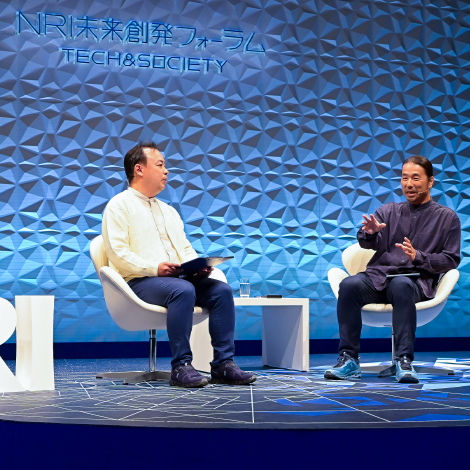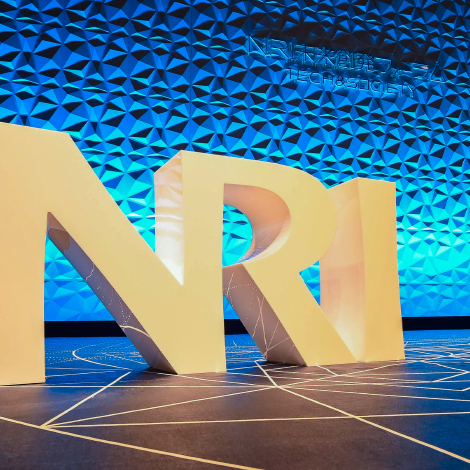Changing Advertising with Data (Part 1) –The Belief Behind the Launch of the New Business “Insight Signal”
Jan. 13, 2021
“Insight Signal” is a service that scientifically measures advertising effectiveness using single source data*. Created in 2007, it is now being used by more than 200 companies as a tool to support marketing strategies. Takao Matsumoto of Nomura Research Institute (NRI), who launched the service, had a strong desire to “change advertising with data.” In this two-part article, we asked him about how the Insight Signal service came to be.
Is there a rationale for the advertisements?
It was in 2006 that Matsumoto transferred to NRI from his previous company.
“I wanted to change advertising with data. In my previous job, I started a number of new businesses in the digital domain, such as Web and mobile-based businesses. In particular, when I was involved in advertising work, I was convinced that there would come a time when data would become absolutely necessary in this domain. However, even if I clamored that “Data is important for advertising!” at my previous job, it seemed to me that I wouldn’t be able to make big waves. In that situation, I thought that I could realize my ideals if I were at NRI, whose mission is to transform the world, and I changed jobs.”
Now that digitalization has become widespread, data utilization is progressing in various fields. However, in the advertising industry at that time, the prevailing thought was that it was better to put advertisements created by famous creators based on their intuition into mass media, rather than delivering advertisements based on data.
“Of course, that way of thinking is also correct. But what does it really mean to move people with advertising? I also wondered if I could untangle that question with data. There are mountains of measurement data asking whether consumers like or dislike advertisements. Not only that, but for example, what kind of changes will occur in the feelings and behaviors of people who see an advertisement, and is there a difference in the attitudes of people who have not seen the advertisement? I wanted to accurately quantify that change.”
Two-year “interview marathon” and “feasibility study”
Although Matsumoto had such strong feelings, he did not have a solid image of a concrete service. He met Junichi Shiozaki (currently the director of the Marketing Science Consulting Department), an NRI consultant who was at that time considering a marketing “visualization” business, and they discussed the outlines of the service. As a result, they thought that ascertaining the needs of advertisers, who would be the customers, would be the first step, and they started an “interview marathon” to listen to what NRI customers had to say.
NRI has many client companies across many industries, but when Matsumoto and his colleagues tried to conduct interviews, they realized that they had relatively few contacts with advertising and marketing related departments.
“In order to make an appointment with the other party, you need a specific customer’s name, and even if we sent a letter addressed to some department, it seemed that they wouldn’t open it. However, at that time there was no such thing as business card management app like we have now. So, I steadily checked information from things like magazines, newspapers, and websites, and actively participated in events, lectures, related organizations, etc. and collected name after name. We conducted many interviews and built a network of people by making phone calls as well as sending letters.”
Even if you have a new idea or highflying concept, no one will pay attention unless there are visible results, so we started a thorough feasibility study for the above network of people.
“We conducted test surveys, actually acquired and analyzed the data, and asked customers for their opinions. Based on the results, we changed the way we collected the data, reviewed the analysis method, and asked for opinions again. We have continued these activities for about two years. Creating a business by ourselves is different from a normal consulting project, and it’s not enough to convince one company—rather, many companies need to be convinced. This was a difficult point. However, as I listened to the stories of the people in charge of advertising and marketing at many companies, I could gradually see the advertising effectiveness they really wanted to know and how to quantify it. From there, our business finally started.”
“Insight signal” prioritizes the “differences-in-differences” analysis method and convincing without black-boxing
After more than two years of trial and error, the new service, “Insight Signal,” was finally born, but Matsumoto says that there were 2 points essential to commercializing the many feasibility studies.
“First of all, we focused on the purpose of measuring advertising effectiveness, that is, what it is used for, rather than just producing evaluation results. In Insight Signal, the same questions regarding target functions such as product recognition and purchase intention are asked to the same person before and after the advertisement is released. At the same time, it keeps track of the same person’s daily media exposures so that you can tell whether or not they’ve been exposed to your advertisement. By doing so, you can compare the changes of people before and after they were exposed to the advertisement with the changes of people who were not exposed to the advertisement before and after its release. This is called “differences-in-differences” and can be used for the PDCA of considering what to do next by putting fair results into the analysis framework.”
In the past, it was a common method to measure the effectiveness of advertisements by ad recognition rate and likability, but this means that you could just use a celebrity with high likability and run a large number of TV commercials. In addition, even if you try to make a determination by whether or not a product sold well, it’s impossible to make an accurate analysis because it will contain many factors other than advertising, such as the selling price, distribution rate at stores, seasonal factors, and the product power itself. By adopting this method of “differences-in-differences”, effectiveness can be measured by the “quantity” and “quality” of pure advertising. While it became clear at a glance that useless advertisements did not lead to purchase intentions, it also became possible to understand whether releasing more advertisements would have led to more sales, or what kind of messaging motivated purchases.
“The next most important thing was not to black-box the analysis. If the logic and method are too difficult when you’re teaching a new way of thinking, it becomes difficult for each company to incorporate the analysis results. It was important make it as easy to understand as possible because there are occasions when we explain to other members and departments, rather than just convincing one person in charge.”
This method does not guess exactly right on everything, and various challenges will need to be met in the going forward but the most important thing is to start from how customers are going to use it. That’s why we will continue with the interviews and improvements we’ve been doing the last two years, and will keep doing them into the future.”

-
*
Single source data: Asking the same person and collecting information from them about their purchasing behaviors after multiple media exposures or before and after an advertisement is released, and thereby making it possible to ascertain the cross-sectional use of media and relationship between media exposures and purchasing activities







